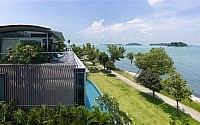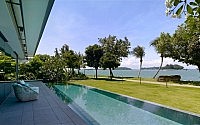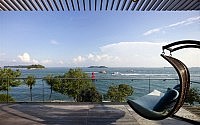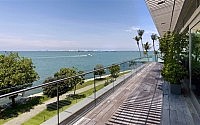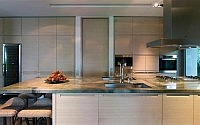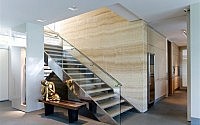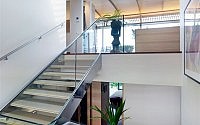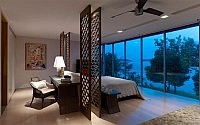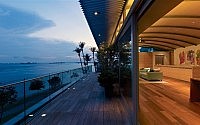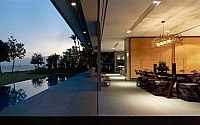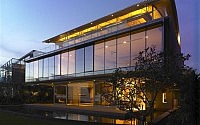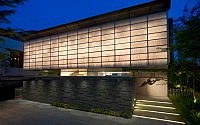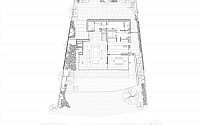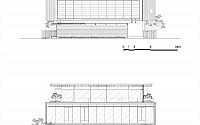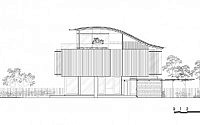Beacon House by WOW Architects
Beacon beach-front house by WOW Architects is located on the southernmost tip of Sentosa Island, at the southernmost part of Singapore.
Description by WOW Architects
Historical and Geographical Context
The land that Sentosa Cove sits on consists partly of reclaimed land and partly of what used to be an isle called Buran Darat that was situated east of Sentosa. In the 1970s, the government’s plan for Buran Darat was to develop it into a recreational centre with a swimming lagoon and facilities for water sports such as boating and canoeing. There was also a proposal to build a bridge to link it to Sentosa. By the late 1980s, the plans had changed. The narrow channel separating Buran Darat and Sentosa was to be reclaimed, and high-end residential homes, a world-class marina and resort-related facilities were to be developed on this new part of Sentosa.
Reclamation works to merge Buran Darat with Sentosa started in November 1991 and were completed in September 1993. Soil improvement works, infrastructure construction and landscaping began in 1994. The marina was in operation by 1999 and the sale of land parcels for private development commenced in 2003. In total, SDC reportedly spent about S$250 million on infrastructure development for Sentosa Cove. The first batch of land parcels was launched for sale in October 2003. By 2008, all land parcels had been released for sale.
The clients being a couple who were well traveled individuals with discerning taste fell in love this particular site immediately after they saw it the Sentosa Cove Development Masterplan back in 2006.The site is literally on the southernmost tip of the entire Sentosa Cove development, thus also being the southernmost house in Singapore main island( if not the South East Asian Land Mass).
Because of its unique location the site has an obstructed view of the ocean, in the center of this expansive view is one of the quirks of the site , a imposing red Bouy. This red Bouy is a beacon and nautical marker , so that ships coming in on the Sisters Fairway can navigate through the Buran channel. This is located at one end of the buran channel where it intersects with the Sisters’ Fairway. Across the Buran channel is a green buoy corresponding to this red one. This red buoy flashes every 2 seconds and is visible from 3 Nautical Miles.
The site also offers fantastic views Pulau Tekor in the south Pulau Serigat in the southeast and on good day a clear view of the Sisters Islands ( Pulau Subar Darat and Pulau Subar Laut) in the South.
The Sisters Fairway is also alive with activity, on any given day from the site , you would be able to see countless barges , boats and ocean liners slowly gliding over the horizon.
Architectural
The Sentosa Cove house was inspired by marine life-forms and maritime elements. Set at the southernmost point of Sentosa Island, the site offers a sweeping view of the sea and an imposing relationship to the ocean front.
Our client was the visionary founder of a global maritime fuel business with a fascination with ocean front properties around the world. Settling in Singapore with his wife and two daughters, he was particularly drawn to Sentosa’s dynamic views of the shipping corridors and mega sea vessels on the horizon juxtaposed against the silhouette of the Sisters’ Islands to the south and the Indonesian archipelago beyond.
The owner requested a house that celebrated the ocean views and uniqueness of Sentosa relative to the other ports which he also called home. They required a design that maximized the ocean views in every part of the house and devoted no resources to a basement or inwardly focused spaces.
We began the design process by understanding the site and the imposing marine elements of Sentosa Cove. The massive stone embankments, marine industrial elements like port cranes, barges and the vulnerable marine life that struggles to survive beneath all the industry and trade. The red buoy in the ocean just in front of the site, that signifies the southernmost point of Singapore was a key reference that guided the design of a house as a beacon celebrating its views, place and time.
The massing of the house was developed into a shaded and layered box that hovers over a dramatic entertainment area set in a garden. The Living, Dining and Kitchen share one huge ocean view room which can be screened and partitioned with sliding panels that disappear within the furnishings. The pool and poolside terrace are an extension of the entertainment area complete with seating and ocean views.
The bedrooms on the second storey are laid out in a masonry portal structure hovering over the entertainment areas on the ground floor. This double layer box, insulated from the heat of the east and west sun was designed to provide shade to the areas on the ground floor that were fully glazed and operable to allow for maximum connection and ocean views without direct sunlight during the hot hours of the day.
The massing of the bedroom level was cantilevered six meters toward the ocean culminating in a floor to ceiling reflective glass box that hovers over the pool foreshortening the distance to the sea to offer a more dynamic focus on the pool and the ocean view. For the street facing façade, a natural onyx curtain wall supported by a stainless steel frame was designed as a lantern or beacon to glow at night reminiscent of its place at the southern most point of Sentosa and Singapore.
The aluminum screen that provides a second insulating layer to the bedroom floor and privacy for the private garden within, was inspired by the baleen of a whale.
Functioning as filter for heat and privacy, the screen functions in concert with the masonry wall and double glazed mirror glass curtain wall to minimize heat-gain during the day and reduce dependence on Air-conditioning through natural cross ventilation.
Above the house, the roof shelters an attic beneath a curving wave inspired by the sinewy fins of a stingray. The roof vaults over the attic and curves down to ensure the street facing side of the house is clearly perceived as a two-storey house. Beneath the curving roof, services and amenities are tucked out of sight and naturally ventilated. The edges and gentle curves lend to its weightless appearance.
For the attic, the owners requested an office for both husband and wife to be able to work from home and make contact with their offices in San Francisco and Rotterdam. Offering a 180o view of the ocean, the attic would be the “Bridge” from which their business would be navigated around the globe. The cantilevered deck overlooking the ocean gives the sensory experience of being on the deck of a great ocean liner.
Landscape
The landscape design is a key conceptual driver of the project. Conceived as the principal element of the ground floor, into which the cool, shady living and dining areas are set, the landscape was perceived as part of the continuous green belt that weaves through the surrounding houses of Sentosa Cove.
The journey through the house starts with the entry at driveway where the visitor is greeted with an articulated stone wall over which an Onyx Lantern hovers. As the main door was positioned to face the west, it gives the illusion there are no openings on the façade of the main entrance. As you enter through the main door surprised to meet with a breathtaking panoramic view of the ocean.
The ground floor or the base of the massing was planned as an open concept with minimal walls in the main living/dining/kitchen area, with the exception of one minimalist cabinet which separates the zones. Modularity of spaces was achieve with the introduction of sliding panels which separate the spaces. The dining room and living is flanked by 2 oversized square glazed doors which open up the whole house to the swimming pool and the ocean beyond. An oversized glass panel with minimal framing was used to allow the maximum vistas to the outside . The kitchen was planned to be an outdoor/indoor kitchen with 2 glass doors which extends the cooking experience to the outside. Even the maids rooms was planned to have unhindered views to the ocean. The entire ground floor was planned to have the ocean breeze flow through it with theuse n of aluminium louvers all around the front of the house. Aluminium was used extensively due the high recyclable attributes of the material.
The Stairs clad in bleached American white oak takes you up to the second floor where a central corridor branches to the bedrooms and gym. The corridor is naturally ventilated with an sky garden which brings in natural light and with its double height volume creates and interesting interaction zone between levels.
As you ascent further up the stair to the attic, you are again greeted with the most expansive view of the ocean. This space, conceived as a work space and chill out zone for the family, is simply breathtaking.
Summary
The ultimate oceanfront house is located on the southern tip of Sentosa Island, at the southernmost part of Singapore. The house’s unique location provides it with an unobstructed 180º view of the ocean all around and is marked by the nautical light beacon ‘Sentosa FI.R.2S3m’ immediately in front of the house in the ocean. The project was inspired by the maritime elements surrounding the site and the vulnerable marine life forms threatened below.
Conceived as a framed portal cantilevered over an open living, dining, pool and garden area, the house structure shades the pool terrace such that it is never exposed to direct sunlight. An aluminium trellis screen wraps around the frame, screening eastand west-facing walls from the intense heat of the sun as well as ensuring privacy from neighbours.
The massing of the house was developed into a shaded and layered box that hovers over a dramatic entertainment area set in a garden. The Living, Dining and Kitchen share one huge ocean view room which can be screened and partitioned with sliding panels that disappear within the furnishings. The pool and poolside terrace are an extension of the entertainment area complete with seating and ocean views.
A vertical aluminum screen provides a second insulating layer to the bedroom floor and privacy for the private garden within, it was inspired by the baleen of a whale. Functioning as filter for heat and privacy, the screen functions in concert with the masonry wall and double glazed mirror glass curtain wall to minimize heat-gain during the day and reduce dependence on Air-conditioning through natural cross ventilation.
The South-facing façade was designed with reflective Low E Glass, to keep the house cool and also to ensure resistance to gale force winds. A reflective surface on the bedroom level adds privacy by preventing views inwards when the curtains are opened. In all instances of glass usage, special attention was paid to its performance data to ensure absence of the greenhouse effect.
To the north, the onyx façade facing the road is designed to be a lantern at night, and as a beacon marking the home, mirroring the light beacon nearby in the ocean. The façade is constructed with a stainless steel frame curtain wall with 5 mm onyx laminated with tempered glass.
Every room in the house enjoys a direct relationship with the oceanfront proximity. The kitchen and dining room can be combined to maximise family interaction, and to allow the kitchen to remain connected to the pool and the ocean view.
Beneath the curve of the attic roof, inspired by the graceful geometry of the stingray, are a study and a sitting room, oriented south with a 180-degree ocean view. A fulllength timber deck flanks the southern end of the attic, cantilevered over the swimming pool and evocative of the experience of being on the deck of a ship.
- by Matt Watts